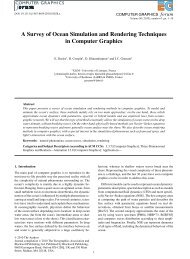Mary
Values and Beliefs_Part III
Values and Beliefs_Part III
- No tags were found...
Create successful ePaper yourself
Turn your PDF publications into a flip-book with our unique Google optimized e-Paper software.
Occupational Therapy<br />
Values and Beliefs: part III<br />
A New View of Occupation and the Profession, 1950–1969<br />
Kathlyn L. Reed<br />
Christine Peters<br />
“I personally have little trust that we<br />
can continue to exist as an arts and<br />
crafts group which services muscle <br />
dysfunction or as an activity group<br />
which services the emotionally <br />
disabled” (p. 4). 1<br />
<strong>Mary</strong> Reilly stated a<br />
major theme leading<br />
to significant change in<br />
occupational therapy<br />
that evolved during the<br />
progressive movement of the 1960s. 1<br />
Inherent in her words is Reilly’s futuristic<br />
view that occupational therapy was<br />
evolving as a science-based profession.<br />
At the same time, occupational<br />
therapy practitioners were increasingly<br />
concerned that arts and crafts, often<br />
viewed as diversional, did not fully<br />
explain the essence of occupation or<br />
occupational therapy. Arts and craft<br />
projects seemed to be overemphasized,<br />
whereas the therapeutic value of occupation<br />
was being underemphasized. 2,3<br />
Of importance to the profession is<br />
whether the values and beliefs inherent<br />
in the arts and crafts movement were<br />
still held within the profession when<br />
the teaching of arts and crafts was<br />
being deemphasized within the curriculum.<br />
A related question is whether<br />
the values and beliefs supported by the<br />
arts and crafts movement was broad<br />
enough to encompass an expanding<br />
view of occupation as a science-based<br />
concept within the profession.<br />
The arts and crafts movement had<br />
advanced a number of ideas and ideals<br />
including design unity, joy in labor<br />
(work), individualism, regionalism,<br />
social responsibility, consistency and<br />
OT PRACTICE • DECEMBER 24, 2007<br />
order, simplicity, and home and hearth<br />
(family and fireplace). 4,5 Many of these<br />
ideas focused on setting a tone and<br />
tempo of life in society through the<br />
organization of habits of work, play, rest,<br />
and sleep. 6 American social values had<br />
changed from conservative in the 1950s<br />
to progressive in the 1960s; in addition,<br />
the practice of medicine had changed<br />
after World War II. 7 Physicians, with a<br />
focus on scientific methods, expanded<br />
their knowledge through working with<br />
former soldiers with physical and mental<br />
disabilities. For example, psychotropic<br />
medication introduced changes in<br />
mental health practice and hospitalization<br />
patterns, leading to community<br />
mental health and mental retardation<br />
legislation in 1963. 8 Given the changes<br />
in medical practice patterns and occupational<br />
therapy’s predominant reliance<br />
on guidance from medicine, the ideas of<br />
the arts and crafts movement may have<br />
been a difficult fit. Medicine was developing<br />
a focus on short-term care, while<br />
the arts and crafts tradition fit better in<br />
a long-term-care approach.<br />
Occupational therapy in physical<br />
medicine and mental health, or<br />
neuropsychiatry as it was referred<br />
to at the time, also had a new agenda.<br />
For example, Shields, Oelhafen, and<br />
Sheeham stated that the role of occupational<br />
therapy in physical medicine is<br />
to increase endurance, improve coordination<br />
and dexterity, improve muscle<br />
power and strength, improve joint range<br />
of motion, relieve tightness of fascial<br />
planes, and obtain the best functional<br />
results. 9 The new focus was on the biomedical<br />
aspects of the body, not on the<br />
social or temporal life of the individual,<br />
which had been more conducive to the<br />
values of the arts and crafts movement.<br />
Similar views of the role of occupational<br />
therapy in physical medicine were<br />
expressed by Cummings, 10 Grove, 11<br />
Helming, 12 and Huddleston. 13 Psychiatry,<br />
on the other hand, was focused on<br />
psychoanalytic psychotherapy, including<br />
the provision of the opportunity<br />
to satisfy the basic emotional need for<br />
security (e.g., the need to be loved,<br />
to be accepted, and to belong). Other<br />
occupational therapy objectives were to<br />
establish an atmosphere conducive to<br />
recovery, assist patients to undertake<br />
appropriate economic and social responsibilities,<br />
provide data for evaluation<br />
and diagnosis, and assist the patient to<br />
bridge the gap between hospital and<br />
community living. 14 Again, the tone and<br />
tempo of the arts and crafts movement,<br />
which emphasized the practical,<br />
hands-on approach of crafts labor, were<br />
deemphasized.<br />
Continuing the Discussion<br />
This article is the third in a series and<br />
continues the process of identifying<br />
and organizing the beliefs, values,<br />
and ideas gleaned from the historical<br />
foundations of the profession. The first<br />
article, “Occupational Therapy Values<br />
and Beliefs: The Formative Years,<br />
1904–1929,” appeared in the April 17,<br />
2006, issue of OT Practice. 15 The<br />
second article, entitled “Occupational<br />
Therapy Values and Beliefs, Part II:<br />
The Great Depression and War Years:<br />
1930–1949,” appeared in the October 9,<br />
2006, issues of OT Practice. 16 The<br />
methods used and themes developed<br />
to guide the historical literature review<br />
project were discussed in the first<br />
two articles, and included economics,<br />
education, health and medicine,<br />
philosophy, politics and government,<br />
professions and professionals, psychology<br />
and psychological concepts, religion<br />
and spirituality, and social themes<br />
and movements. This article discusses<br />
some new categories that became evident<br />
in a literature search from 1950 to<br />
17
Figure 1. A Statement of Basic Philosophy, Principle and Policy (p. 159) 19<br />
Occupational therapy is particularly concerned with man and his ability to meet the<br />
demands of his environment. The therapist administers treatment to the patient<br />
designed to (1) evaluate and increase his physical function in relation to activities<br />
of daily living, the needs of his family, and the requirements of his job, (2) improve<br />
his self-understanding and psychosocial function as a total human being. Treatment<br />
involves the scientific use of activity procedures and/or controlled social relationships<br />
to meet the specific needs of the individual patient.<br />
Figure 2. Statement of Policy (p. 24) 20<br />
1. Maintain and control the voluntary registration of its practitioners.<br />
2. Regulate, in conjunction with the Council on Medical Education and hospitals of the<br />
American Medical Association, the education of occupational therapists to prepare<br />
them for their treatment function.<br />
3. Establish and maintain standards of clinical practice in occupational therapy which<br />
will improve patient treatment.<br />
4. Foster continuing growth in the professional competence of occupational therapists.<br />
5. Encourage and facilitate increase in the body of specific occupational therapy knowledge<br />
available to physicians.<br />
6. Protect the standards of occupational therapy and the environment in which the<br />
occupational therapist functions.<br />
7. Strongly oppose and protest any administrative policy or structure which ignores or<br />
weakens the treatment function of occupational therapy.<br />
1969. These categories will not follow<br />
the previous theme format. Rather, the<br />
topics represent a sampling of concerns<br />
addressed either by the American<br />
Occupational Therapy Association<br />
(AOTA) Board of Management, or concerns<br />
external to the Association that<br />
shaped occupational therapy practice,<br />
education, or both.<br />
The Greater Profession<br />
Defining Occupational Therapy<br />
In 1969, for the first time, AOTA<br />
adopted the following formal definition<br />
of occupational therapy: “Occupational<br />
Therapy is the art and science<br />
of directing man’s response to selected<br />
activity to promote and maintain<br />
health, to prevent disability, to evaluate<br />
behavior and to treat or train patients<br />
with physical or psychosocial dysfunction”<br />
(p. 185). 17 This official definition<br />
replaced the commonly used definition<br />
that Pattison had developed in<br />
1922 18 and expanded the description<br />
conveyed in AOTA’s 1963 A Statement<br />
of Basic Philosophy, Principle and<br />
Policy 19 (see Figure 1). This definition,<br />
along with AOTA’s 1958 definitions<br />
of function 14 and 1961 Statement of<br />
Policy 20 (see Figure 2), outlined the<br />
thought and direction of the occupational<br />
therapy profession and AOTA<br />
during the 1960s.<br />
Responses From the Association<br />
In response to changes in the profession<br />
during this time, the Association<br />
provided more direction and published<br />
more books. Of special interest are<br />
the previously mentioned documents<br />
Statement of Policy, 20 and A Statement<br />
of Basic Philosophy, Principle<br />
and Policy, 19 along with two manuals:<br />
The Objectives and Functions of<br />
Occupational Therapy 14 and Occupational<br />
Therapy Reference Manual<br />
for Physicians. 21 The two statements<br />
provided a description of the role of<br />
the Association and of occupational<br />
therapy. The two manuals outlined and<br />
detailed the services provided. The<br />
manuals and statements have been<br />
used as references in the preparation of<br />
this article. Perhaps of greatest value to<br />
the profession was the role of the Association<br />
in providing publications that<br />
were written by occupational therapists<br />
instead of relying on external publishing<br />
sources and physicians to advance<br />
the knowledge base and profession of<br />
occupational therapy.<br />
Eleanor Clarke Slagle Lectureship<br />
and Award of Merit<br />
To recognize the value of professional<br />
contributions, the Association<br />
established the Eleanor Clarke Slagle<br />
lectureship in 1953. 22 The “honorary<br />
occupational therapy guest lectureship”<br />
was to be awarded “in recognition<br />
of meritorious service to the profession”<br />
(p. 24). 22 “It perpetuates the<br />
memory of Mrs. Eleanor Clarke Slagle,<br />
one of the outstanding pioneers in<br />
the field (profession) of occupational<br />
therapy. The award is bestowed upon<br />
practicing therapists who are members<br />
of the AOTA and who have made or are<br />
making a significant contribution to the<br />
profession” (p. 24). 21 Since its inception,<br />
the Slagle lectureship has been<br />
given to 44 individuals. The Award of<br />
Merit had already been established in<br />
1950 to recognize distinguished service<br />
to the profession. 23<br />
Changes in Practice Areas<br />
Practice areas were also changing relative<br />
to advances in technology, medicine,<br />
and pharmacology. Occupational<br />
therapists had worked with clients who<br />
had tuberculosis from the start of the<br />
profession, but sanatoriums treating<br />
tuberculosis were closing as drug<br />
therapy permitted outpatient care. The<br />
literature reflects the diminished practice<br />
area of tuberculosis, with the last<br />
article on this topic appearing in the<br />
American Journal of Occupational<br />
Therapy (AJOT) in 1960. 24 Similarly,<br />
the polio vaccination decreased rapidly<br />
the number of new cases of poliomyelitis<br />
in children and adults, and the last<br />
article on polio in AJOT appeared in<br />
1957. 25 Curiously, vocational rehabilitation<br />
grants were still funding postprofessional<br />
education for occupational<br />
therapists in the areas of tuberculosis<br />
and polio, which kept them in both<br />
practice areas despite fewer patients. 26<br />
During this time, as occupational<br />
therapists became more sophisticated<br />
18 DECEMBER 24, 2007 • WWW.AOTA.ORG
in their education and their knowledge<br />
base grew, new areas of treatment<br />
appeared or were expanded on in the<br />
literature. For example, interest in neurology<br />
and perceptual motor dysfunction<br />
was increasing, 27,28 and articles<br />
on neurophysiology and facilitation<br />
techniques began to appear. 29,30<br />
Activities of Daily Living<br />
A major new focus for occupational<br />
therapy was activities of daily living.<br />
The first form to assess activities of<br />
daily living appearing in the occupational<br />
therapy literature was the<br />
1949 Scale for Rating Functional<br />
Demands for Daily Living. 31 However,<br />
the term activities of daily living<br />
did not become popular in the occupational<br />
therapy literature until the<br />
1950s. According to Isaac, 32 physician<br />
Howard Rusk, working with returning<br />
soldiers, established rehabilitation after<br />
World War II. Rush defined activities of<br />
daily living as “all those little things a<br />
person does for himself, that make him<br />
miserable if he is unable to do them”<br />
(p. 58). 32 Clinically, the initial work to<br />
develop the principles of activities of<br />
daily living was done at the Institute<br />
for the Crippled and Disabled in New<br />
York City, but spread quickly across<br />
the country in all areas of occupational<br />
therapy practice.<br />
The concepts of independence and<br />
independent living were closely associated<br />
with activities of daily living. 33 The<br />
independent living movement is closely<br />
aligned with the physical rehabilitation<br />
efforts of occupational therapy, but it is<br />
not as clearly defined in occupational<br />
therapy mental health history. Occupational<br />
therapists working in mental<br />
health were exposed to various ways of<br />
conceptualizing activities of daily living.<br />
For example, Maxwell Jones’s 1953 The<br />
Therapeutic Community 34 focused<br />
on role equality, with patients and staff<br />
members taking equal responsibility for<br />
daily housecleaning chores on a hospital<br />
unit or ward. In the 1950s, the community-based<br />
clubhouse models like<br />
Fountain House in New York created<br />
real-life situations for former patients<br />
to gather and share responsibility for<br />
the daily running and maintenance<br />
of their centers, from light cooking to<br />
administrative work. 35<br />
Prescription Versus Referral<br />
Although physicians continued to<br />
supervise occupational therapists, the<br />
nature of this relationship was changing.<br />
In 1958 Mazer and Goodrich suggested<br />
that the prescription for psychiatric<br />
occupational therapy services was<br />
an anachronistic procedure and should<br />
be discontinued. 36 The argument was<br />
that occupational therapists did not<br />
need to have the details for treating a<br />
patient spelled out in a prescribed form<br />
because as professionals they could<br />
determine the needs for themselves.<br />
They needed the physician’s permission<br />
to see the patient but could supply<br />
the expertise regarding treatment<br />
and intervention without physician<br />
assistance. Fidler concurred, 37 and in<br />
1964 the AOTA Board of Management<br />
recommended that the term referral<br />
be used in place of prescription. 38 In<br />
1969 the first statement on occupational<br />
therapy referral was adopted by the<br />
Association. 39 Zamir expanded on the<br />
The Most Thorough and Practical<br />
Sensory Integration Training in the World<br />
USC/WPS Comprehensive Program in Sensory Integration<br />
This four-course series covers sensory integration theory, assessment, interpretation, and intervention.<br />
• You’ll learn from master clinicians, many of whom studied directly with Dr. A. Jean Ayres<br />
• You’ll learn how to apply sensory integration principles to treat learning, behavior,<br />
and developmental disorders<br />
• You’ll learn practical clinical techniques, demonstrated with real children<br />
• You’ll learn how to administer the Sensory Integration and Praxis Tests (SIPT),<br />
according to standards approved by the test publisher<br />
• You’ll earn 30 contact hours of continuing education credit for each course—<br />
and when you complete the series, a Certificate in Sensory Integration<br />
issued by the USC Division of Occupational Science and Occupational Therapy<br />
and Western Psychological Services<br />
UPCOMING<br />
COURSES IN:<br />
Los Angeles, CA<br />
Atlanta, GA<br />
Chicago, IL<br />
Boston, MA<br />
wps®<br />
Western Psychological Services<br />
OT PRACTICE • DECEMBER 24, 2007<br />
For a complete schedule or to register:<br />
Visit wpspublish.com<br />
Call 800-648-8857<br />
For information, go to www.hartleydata.com/OT<br />
Occupational Science and Occupational Therapy<br />
P-2782<br />
19
challenge to the relationship between<br />
medicine and occupational therapy<br />
by stating that history had shown<br />
that professional development almost<br />
always demands autonomy. 40 She<br />
further stated that it was doubtful that<br />
any field could truly call itself a profession<br />
if it was merely a tool of another<br />
profession, working only under its<br />
direction and at its behest. Bockoven<br />
suggested that occupational therapy<br />
separate from medicine and focus on<br />
its concern for occupation. 41<br />
Registration Versus Licensure<br />
Although change was happening in<br />
some areas of occupational therapy,<br />
professional beliefs about the value of<br />
state licensure remained unchanged.<br />
In 1951 Wilma L. West, as executive<br />
director of AOTA, summarized the<br />
accepted view of state licensure as<br />
not necessary. 42 Licensure was seen<br />
as a potential barrier to recruiting<br />
students (more costs), expensive to<br />
obtain because of legal fees, and having<br />
the potential to hinder the movement<br />
of occupational therapists across the<br />
country because states might have<br />
different requirements in their licensure<br />
regulations. The negative view of<br />
licensure was reinforced in 1969 when<br />
a position paper was adopted by the<br />
AOTA Delegate Assembly, stating that<br />
licensure had “done little to protect<br />
either the providers or consumers of<br />
specific services” and represented “an<br />
external attempt at imposing qualifications<br />
for entrance into the profession<br />
and to engage in practice” (p. 529). 43 A<br />
more positive view of licensure would<br />
not occur for several years.<br />
Occupational Therapy Education<br />
Occupational therapy curriculum<br />
design also began to change during this<br />
period. A new concern was expanded<br />
courses in medical conditions, activities<br />
analysis, and therapeutic application,<br />
and a move away from a predominant<br />
arts and crafts curriculum. Nedra Gillette<br />
illustrated these shifts in 1965<br />
when she summarized the recommendations<br />
of the AOTA Curriculum Study<br />
project as follows:<br />
…it was recommended that the<br />
traditional arts and crafts be deemphasized<br />
as treatment media<br />
with decreased time devoted to<br />
these in the curricula, decreased<br />
number of media taught, emphasis<br />
on methods of acquiring skills, and<br />
teaching of a core course in media.<br />
(p. 352) 44<br />
Not only was curriculum content<br />
revamped, but occupational therapy<br />
levels of education became a topic of<br />
discussion. Given the 1963 adoption<br />
of a baccalaureate degree required for<br />
professional-level education, there was<br />
discussion about graduate education to<br />
promote scholarship.<br />
Graduate Education<br />
With a need for more research and for<br />
better-prepared occupational therapists<br />
in specialty areas of practice, came a<br />
need for occupational therapists with<br />
postprofessional degrees. Academic<br />
leaders discussed two entrances to<br />
occupational therapy graduate education.<br />
The first was a master’s degree in<br />
occupational therapy for baccalaureate-trained<br />
occupational therapists<br />
who were already practicing. The<br />
more controversial second option was<br />
a master’s degree as the entry level to<br />
practice. 45 The document A Guide for<br />
the Development of Graduate Education<br />
Leading to Higher Degrees in<br />
Occupational Therapy was adopted<br />
in 1958. 46 In 1964 the first proposed<br />
master’s-level entry program, at the<br />
University of Southern California, was<br />
submitted and discussed in the Council<br />
on Education. 47<br />
Certified Occupation Therapy Assistants<br />
The lack of trained occupational therapists,<br />
particularly in large state hospitals,<br />
was also a focus of concern. 48,49 In<br />
1957 the AOTA Board of Management<br />
voted to accept the title Certified Occupational<br />
Therapy Assistant (COTA)<br />
and to adopt the standards for organizing<br />
a training program for occupational<br />
therapy assistants. 50 Educational<br />
programs for the occupational therapy<br />
assistant developed quickly throughout<br />
the country. Occupational therapy<br />
personnel were now recognized at two<br />
levels: professional and technical.<br />
Summary<br />
The years 1950 to 1969 witnessed<br />
change and growth of occupational<br />
therapy practice, education, and<br />
organization. Practice responded to the<br />
need for more organization of information<br />
into models to guide the development<br />
of theoretical knowledge and<br />
practice skills. Educational opportunities<br />
in occupational therapy expanded<br />
through the development of more<br />
schools at the professional level and<br />
the initiation of schools at the technical<br />
level. The professional organization<br />
recognized the need for assistants to<br />
provide more manpower in occupational<br />
therapy practice, changed the<br />
relationships with physicians from<br />
prescription to referral, and facilitated<br />
the publication of more manuals and<br />
textbooks on occupational therapy<br />
written by occupational therapists. n<br />
References<br />
1. Reilly, M. (1962). Eleanor Clarke Slagle Lecture—Occupational<br />
therapy can be one of the<br />
great ideas of 20th century medicine. American<br />
Journal of Occupational Therapy, 16, 1–9.<br />
2. [Murphy, L. S.] (1951). Editorial: Disemphasizing<br />
crafts. American Journal of Occupational<br />
Therapy, 5, 39.<br />
3. [Murphy, L. S.] (1951). Editorial: Occupation or<br />
therapy. American Journal of Occupational<br />
Therapy, 5, 117–118.<br />
4. Cummings, E., & Kaplan, W. (1991). The arts and<br />
crafts movement. London: Thames and Hudson.<br />
5. Kaplan, W. (1989). “The art that is life”: The arts<br />
and crafts movement in America, 1985–1920.<br />
Boston: Museum of Fine Arts.<br />
6. Meyer, A. (1922). Philosophy of occupation<br />
therapy. Archives of Occupational Therapy, 1,<br />
1–10.<br />
7. Starr, D. (1982). The social transformation of<br />
American medicine. New York: Basic.<br />
8. Community Mental Health and Mental Retardation<br />
Act. P.L. 88-164.<br />
9. Shields, C. S., Oelhafen, W. R., & Sheeham, H. R.<br />
(1952). The role of occupational therapy in the<br />
physical medicine management of physical disabilities.<br />
Southern Medical Journal, 45, 395–400.<br />
10. Cummings, V. (1968). The occupational therapist.<br />
Canadian Nurse, 64, 38–39.<br />
11. Grove, E. (1969). Occupational therapy and the<br />
nurse. Nursing Times, 65, 141–143.<br />
12. Helming, F. (1964). What the nurse should know<br />
about OT. Journal of Nursing Education, 3, 7–8,<br />
25–26.<br />
13. Huddleston, O. L. (1956). Use of occupational<br />
therapy in physical rehabilitation. Archives of<br />
Physical Medicine and Rehabilitation, 37, 31–36.<br />
14. American Occupational Therapy Association.<br />
(1958). The objectives and functions of occupational<br />
therapy. Dubuque, IA: Wm. C. Brown.<br />
15. Reed, K. L. (2006). Occupational therapy values<br />
and beliefs. The formative years: 1904–1929.<br />
OT Practice, 11(7), 21–23.<br />
16. Reed, K. L., & Peters, C. (2006). Occupational<br />
therapy values and beliefs, Part II. The great<br />
depression and war years: 1930–1949. OT Practice,<br />
11(18), 17–22.<br />
17. American Occupational Therapy Association.<br />
(1969). Definition of occupational therapy. American<br />
Journal of Occupational Therapy, 23, 185.<br />
18. Pattison, H. A. (1922). The trend of occupational<br />
therapy for the tuberculosis. Archives of Occupational<br />
Therapy, 1, 19–24.<br />
19. American Occupational Therapy Association.<br />
(1963). A Statement of Basic Philosophy, Principle<br />
and Policy. American Journal of Occupational<br />
Therapy, 17, 159.<br />
20. American Occupational Therapy Association.<br />
(1961). Statement of policy. American Journal of<br />
Occupational Therapy, 15, 24.<br />
20 DECEMBER 24, 2007 • WWW.AOTA.ORG
21. American Occupational Therapy Association.<br />
(1960). Occupational therapy reference manual<br />
for physicians. New York: Author.<br />
22. American Occupational Therapy Association.<br />
(1954). Annual reports: Meetings of the House of<br />
Delegates. American Journal of Occupational<br />
Therapy, 8, 24.<br />
23. American Occupational Therapy Association.<br />
(1950). Meetings of the Board of Management.<br />
American Journal of Occupational Therapy, 4,<br />
236.<br />
24. Appleby, L., Morton, J. E. C., Lawson, R. A.,<br />
Loudon, R. G., & Brown, J. (1960). Toward a<br />
therapeutic community in a tuberculosis hospital.<br />
American Journal of Occupational Therapy, 14,<br />
117–120.<br />
25. Halford, M. A. (1957). I had polio. American Journal<br />
of Occupational Therapy, 11, 129–130, 166.<br />
26. Peters, C. O. (2005). Power and professionalism<br />
in occupational therapy. Doctoral dissertation,<br />
New York University.<br />
27. Ayres, A. J. (1963). Eleanor Clarke Slagle<br />
Lecture—The development of perceptual-motor<br />
abilities: A theoretical basis for treatment of<br />
dysfunction. American Journal of Occupational<br />
Therapy, 17, 221–225.<br />
28. Ayres, A. J. (1965). Patterns of perceptual-motor<br />
dysfunction in children: A factor analytic study.<br />
Perceptual and Motor Skills, 20, 335–368.<br />
29. Ayres, A. J. (1955). Proprioceptive facilitation<br />
elicited through the upper extremities: Part I:<br />
Background. American Journal of Occupational<br />
Therapy, 9, 1–9, 50.<br />
30. Rood, M. S. (1956). Session on Neurology: Neurophysiological<br />
mechanisms utilized in the treatment<br />
of neuromuscular dysfunction. American<br />
Journal of Occupational Therapy, 10, 220–225.<br />
31. McLean, F. M. (1949). Occupational therapy in the<br />
management of poliomyelitis. American Journal<br />
of Occupational Therapy, 3, 20–27.<br />
32. Isaac, A. M. (1963). Re-education. Journal of the<br />
Kansas Medical Association, 64, 58–62.<br />
33. Hightower, M. D. (1966). Independence through<br />
activities of daily living. Delaware Medical Journal,<br />
38, 238–242.<br />
34. Jones, M. (1953). The therapeutic community.<br />
New York: Basic.<br />
35. Flannery, M., & Glickman, M. (1996). Fountain<br />
house: Portraits of lives reclaimed from mental<br />
illness. Center City, MN: Hazelden.<br />
36. Mazer, J., & Goodrich, W. (1958). The prescription:<br />
An anachronistic procedure in psychiatric<br />
occupational therapy. American Journal of<br />
Occupational Therapy, 12, 165–170.<br />
37. Fidler, G. S. (1963). Nationally Speaking—The<br />
prescription in occupational therapy. American<br />
Journal of Occupational Therapy, 17, 122–124.<br />
38. American Occupational Therapy Association.<br />
(1964). Board of Management minutes. American<br />
Journal of Occupational Therapy, 18, 165–170.<br />
39. American Occupational Therapy Association.<br />
(1969). Statement on occupational therapy referral.<br />
American Journal of Occupational Therapy,<br />
23, 530–531.<br />
40. Zamir, L. J. (1966). Editorial: Whither occupational<br />
therapy. American Journal of Occupational<br />
Therapy, 20, vii, 195.<br />
41. Bockoven, J. S. (1968). Challenge of the new clinical<br />
approaches. American Journal of Occupational<br />
Therapy, 22, 23–25.<br />
42. West, W. L. (1951). From the executive director.<br />
American Journal of Occupational Therapy, 5,<br />
60–63.<br />
43. American Occupational Therapy Association.<br />
(1969). Licensing and standards of competency<br />
in occupational therapy. American Journal of<br />
Occupational Therapy, 23, 529–530.<br />
44. Gillette, N. P. (1965). Guest Editorial: Occupational<br />
therapy education and the curriculum study<br />
project. American Journal of Occupational<br />
Therapy, 19, 351–353.<br />
45. American Occupational Therapy Association.<br />
(1958). Committee on Graduate Study. American<br />
Journal of Occupational Therapy, 12, 109–110.<br />
OT PRACTICE • DECEMBER 24, 2007<br />
46. American Occupational Therapy Association.<br />
(1958). A guide for the development of graduate<br />
education leading to higher degrees in occupational<br />
therapy. American Journal of Occupational<br />
Therapy, 12, 334–335.<br />
47. American Occupational Therapy Association.<br />
(1964). Council on Education. American Journal<br />
of Occupational Therapy, 18, 266–269.<br />
48. Poole, M. A., & Kassalow, S. (1968). Manpower<br />
survey report: Wisconsin Occupational Therapy<br />
Association. American Journal of Occupational<br />
Therapy, 22, 304–308.<br />
49. Stattel, F. M. (1966). The occupational therapist<br />
in rehabilitation: Projections toward the future.<br />
American Journal of Occupational Therapy, 20,<br />
144–150.<br />
50. American Occupational Therapy Association.<br />
(1958). Report of the project committee on<br />
recognition of OT assistants. American Journal<br />
of Occupational Therapy, 12, 38–39.<br />
P-2340<br />
Kathlyn L. Reed, PhD, OTR, FAOTA, MLIS, is an<br />
associate professor at the School of Occupational<br />
Therapy at Texas Woman’s University–Houston<br />
Center. She is also the chairperson of AOTA’s Ethics<br />
Commission.<br />
Christine Peters, PhD, OTR/L, is an associate professor<br />
of Occupational Therapy at Pacific University in<br />
Hillsboro, Oregon. At the time of the writing she was<br />
supported by the National Institute on Disability and<br />
Rehabilitation Research (H133PO50006) as a postdoctoral<br />
fellow at the University of Medicine and<br />
Dentistry of New Jersey in Psychiatric Rehabilitation.<br />
She is a member of AOTA’s Mental Health Evidence-Based<br />
Literature Review Resource Advisory<br />
Group (2007–2008).<br />
introducing the evo.clicker<br />
…button retractable<br />
totally ergonomic, therapeutic<br />
and very cool. Order some today.<br />
The evo.pen was the first writing instrument to receive a<br />
Commendation from the Arthritis Foundation.<br />
The evo.pen is lectured about by Ms. <strong>Mary</strong> Benbow, MS, OTR,<br />
author of the chapter on handwriting in the Mosby Medical Text,<br />
Hand Function and the Child.<br />
Lectured about by Lindsey Biel, OTR/L, co-author of<br />
Raising a Sensory Smart Child.<br />
Millions distributed through the<br />
Therapeutic Community and Special Education Departments.<br />
Reported as the possible “Future of Writing” on the<br />
front page of U.S.A. Today.<br />
Blue button…Blue ink.<br />
Black button…Black ink.<br />
please go to www.evopen.com<br />
For information, go to www.hartleydata.com/OT<br />
21









